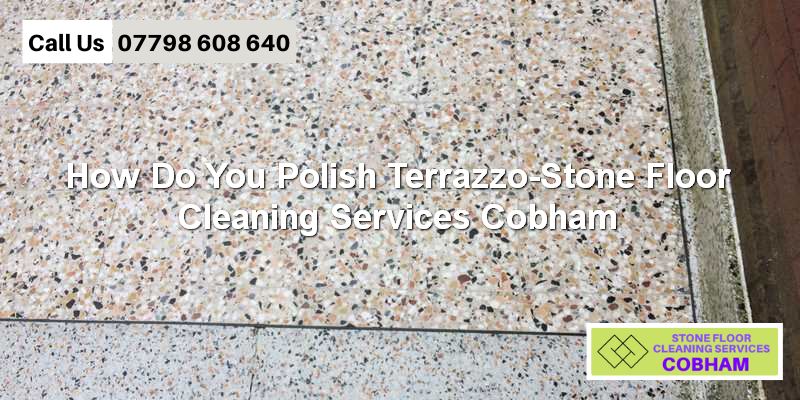How Do You Polish Terrazzo?

Terrazzo floors are a beautiful, durable option that lasts for decades with proper care and maintenance.
In the UK, Terrazzo was a popular flooring for hallways, kitchens and utility rooms throughout the early and mid-20th century.
Today homeowners wishing to restore the original appearance of these homes are discovering Terrazzo hallway and kitchen floors hidden under carpet and Lino. However, like any floor, Terrazzo will become worn and dull over time, losing its original finish and shine. Fortunately, we can restore terrazzo floors to their former glory through restoration and polishing.
In this article, we will delve into the details of terrazzo floor polishing and restoration, including the tools and techniques involved, the steps of the process, and the benefits of professionally polished terrazzo floors. We will also discuss the differences between grinding, honing, and polishing Terrazzo and the various finishes available through these processes.
What is Terrazzo?
Before we dive into terrazzo floor polishing, it's helpful to understand what Terrazzo is.
Terrazzo is a precast or poured-in composite material for floor and wall coverings and staircases. Chips of marble, quartz, granite, glass or other suitable material are mixed with a cement or epoxy matrix. Poured epoxy, cement terrazzo and terrazzo tile floors are ground and polished to create a smooth, uniformly textured surface. Precast cement terrazzo, including wall slabs, skirting units, stair units and tiles, are supplied ready-finished.
Terrazzo is a common choice for commercial, public and domestic buildings because of its durability, versatility, and low maintenance requirements.
Tools and Techniques for Polishing Terrazzo
Several techniques are available to polish terrazzo floors, depending on the condition and the desired outcome.
- Diamond grinding: Diamond grinding involves using a heavy-duty machine equipped with diamond-tipped blades to grind down the surface of the Terrazzo. This process resurfaces old and worn finishes, deep scratches, stains, and other imperfections from the floor.
- Honing: Honing is similar to grinding but uses a finer grit of diamonds and a lighter touch to remove scratches left by grinding and prepare the floor for polishing. Honing also removes moderate scratches and imperfections on floors in reasonable condition.
- Polishing: Polishing is the final step in the terrazzo restoration process, and it involves using progressively finer grits of diamonds to create a sheen or reflective surface.
Older cementitious terrazzo floors usually have areas of damage that need professional restoration. Common restoration issues are
Significant floor cracks.
Cracks in Terrazzo are usually a result of subfloor issues and settlement. Cracking is traditionally associated with older floors; by now, any subfloor issues will have resolved themselves.If the Terrazzo has debonded from the underlying concrete, we can inject a suitable adhesive to help stabilise the area. We clean the crack to remove any loose material and then fill it with coloured resin and small marble chips. The small chips help the repair blend into the floor.
Cracks and broken Terrazzo in doorways
Terrazzo floors usually stop at the doorway, so hammering in nails breaks away the edge of the Terrazzo. It is surprising how much damage can occur. Where possible, the damaged we glue the Terrazzo pieces back in place and replace any areas of lost Terrazzo with a resin or cement Terrazzo repair.
Large holes from lost chippings.
We can fill these holes with a coloured resin to match the original colour.
Holes and damage from removing carpet gripper nails
As in doorways, installing carpet gripper nails can crack the Terrazzo and removing them causes more damage.The areas of damage are cleaned and then filled with a coloured repair mix.
Extensive repairs
Older floors from the start of the 20th century are often damaged to accommodate gas and other service pipes.Matching these repairs to the original floor is more challenging, mainly because the original filler chip sizes and colours are no longer available.Nevertheless, a sensitive repair using modern materials will give an attractive result in keeping with the floor's overall appearance.Once the repair has cured, it is honed and polished to match the surrounding floor.Finally, we seal the floor with an appropriate sealer to help maintain the finish and aid in cleaning.
As you can imagine from the above, polishing Terrazzo is not for the faint-hearted, needing skill and plenty of experience. Hopefully, you can now choose a company to polish your Terrazzo floors.
Frequently Asked Questions
Does terrazzo need polish?
Terrazzo flooring requires regular care and maintenance with specific products to maintain its finish. At least once each week, you should thoroughly your terrazzo floor and check if any areas need polishing.
How do you refresh terrazzo?
Diamond polishing is the best way to refresh terrazzo floor. The diamond polishing process removes everyday scuffs and scratch marks.
Can you buff terrazzo?
Whether poured on-site or laid in tile form, terrazzo occasionally has to be re-polished and buffed to retain its smooth, glossy surface.